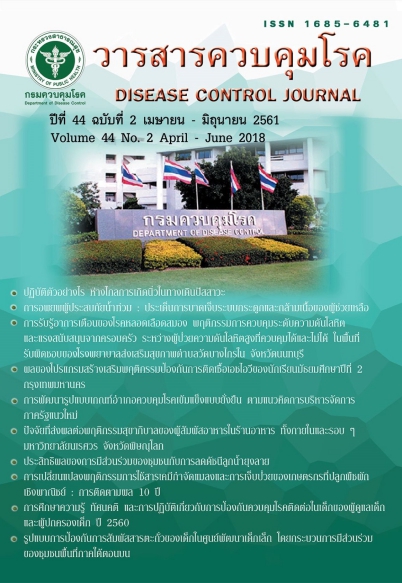The effects of promotion program for HIV prevention behaviors of grade 8 students in Bangkok
DOI:
https://doi.org/10.14456/dcj.2018.14Keywords:
AIDS and HIV infection, HIV prevention behaviors, junior high school studentsAbstract
At present, HIV infection in Thai youth is increasing due to harmful risk behaviors. This quasi-experimental research aimed to study the effect of a program promoting HIV prevention behaviors among junior high school students. The studied samples were 24 grade 8th students in a school in Bangkok. One grade-8 classroom was randomly selected from the Bangkok educational region; and all students of the class were recruited for the study. The study was conducted in three phases. The first phase emphasized on the study of primary data (elicit knowledge and perception) regarding AIDS and HIV prevention of the youth for developing the study program. The second phase dealed with implementation of the program learning activities. The third phase involved evaluation of the program effectiveness. Data were collected by a self-administered questionnaire and were described by frequency, percent, mean, standard deviation and paired t-test. Results of the study revealed that after the experimental group participated in the program, they gained significantly higher mean scores on knowledge about AIDS and HIV prevention, attitude toward HIV prevention behaviors, and perceived self-efficacy in prevention of HIV (p<0.05) when compared to those before participating in the program. The mean score of HIV prevention behaviors was found to be higher than that gained before the experimentation, though it was not statistically significant (p>0.05). These results indicated the effectiveness of the program which was developed and based on the elicit knowledge and perceptions of the youth. Therefore, the program could be applied to design learning activities for students in other junior high schools as well as other related age group students in order to enhance the students to gain more knowledge and skills in performing proper HIV prevention behaviors.
Downloads
References
2. ศูนย์อำนวยการบริหารจัดการปัญหาเอดส์แห่งชาติ. ภาพรวมสถานการณ์ [อินเทอร์เน็ต]. [สืบค้นเมื่อ 16 ก.ค. 2559]. แหล่งข้อมูล: http://www.aidszeroportal.org/
3. บังอร เทพเทียน, สุพัตรา ศรีวณิชชากร, ประภาพรรณ จูเจริญ. การเฝ้าระวังพฤติกรรมที่สัมพันธ์กับการ ติดเชื้อเอชไอวี ใน 9 กลุ่มประชากรเป้าหมาย พื้นที่กรุงเทพมหานคร ปี 2558. นครปฐม: สถาบันพัฒนาสุขภาพอาเซียน มหาวิทยาลัยมหิดล; 2558.
4. วราภรณ์ บุญเชียง, วิลาวัณย์ เตือนราษฎร์, วารุณี ฟองแก้ว, พิมพาภรณ์ กลั่นกลิ่น. ความรู้เกี่ยวกับการ
ติดเชื้อเอชไอวี/เอดส์ และเจตคติต่อพฤติกรรมทางเพศของวัยรุ่นตอนต้น. วารสารสภาการพยาบาล
2556;28:124-37.
5. Nostlinger C, Niderost S, Gredig D, Platteau T, Gordillo V, Roulin C, et al. Swiss HIV cohort study; Eurosupport 5 study group. AIDS Patient Care STDS 2010;24:771-80.
6. วรวรรณ์ ทิพย์วารีรมย์, นันท์นภัส สารพานิช. การพัฒนาโปรแกรมป้องกันพฤติกรรมเสี่ยงทางเพศ ในนักเรียนมัธยมศึกษาตอนต้น ตำบลพลายชุมพล อำเภอเมือง จังหวัดพิษณุโลก. วารสารการพยาบาลและสุขภาพ 2555;3:94-106.
7. Fisher JD, Fisher WA. Changing AIDS-risk behavior. Psychol Bull 1992;111:455-74.
8. Fleiss JL. Statistical method for rate and proportion. 2nd ed. New York: John Willey & Sons; 1981.
9. แพรวทิพฑ์ สุธีรประเสริฐ. ผลของโปรแกรมการสนับสนุนทางสังคมเพื่อป้องกันพฤติกรรมเสี่ยงทางเพศของวัยรุ่น ในโรงเรียนเขตอำเภอเมือง จังหวัดอุบลราชธานี. การประชุมวิชาการและนำเสนอผลงานวิจัยระดับชาติ ราชธานีวิชาการ ครั้งที่ 1 “สร้างเสริมสหวิทยาการ ผสมผสานวัฒนธรรมไทย ก้าวอย่างมั่นใจเข้าสู่ AC; วันที่ 29 กรกฎาคม 2559; มหาวิทยาลัยราชธานี, อุบลราชธานี. อุบลราชธานี: 2559. หน้า 1768-83
10. ชนากานต์ บุญนุช, ยุวดี เกตสัมพันธ์, สุทธิพล อุดมพันธุรัก, จุฬาภรณ์ พูลเอี่ยม, ปรีชญา พลเทพ, สมาชิก CoP วิจัย. ขนาดกลุ่มตัวอย่างในงานวิจัยเชิงปริมาณ [อินเทอร์เน็ต]. [สืบค้นเมื่อ 20 ก.ค. 2559]. แหล่งข้อมูล:http://www1.si.mahidol.ac.th/km/node/1401
11. Bloom BS. Handbook on formative and summative evaluation of student learning.
New York: McGraw-Hill; 1971.
12. Ajzen I, Fishbein M. Understanding attitudes and predicting social behavior. New Jersey: Prentice-Hall; 1980.
13. Ybarra ML, Korchmaros JD, Prescott TL, Birungi R. A randomized controlled trial to increase HIV preventive information, motivation, and behavioral skills in Ugandan adolescents. Ann Behav Med 2015;49:473-85.
14. Singh S. Study of the effect of information, motivation and behavioral skills (IMB) intervention in changing AIDS risk behavior in female university students. AIDS Care 2003;15:71-6.
15. ศรีพรรษ์ ถาวรรัตน์, ปัญญรัตน์ ลาภวงศ์วัฒนา, ณักมล ชาญสาธิตพร. ผลของโปรมแกรมการให้ข้อมูลข่าวสาร การสร้างแรงจูงใจ และการพัฒนาทักษะต่อพฤติกรรมสุขภาพทางเพศ ของนักเรียนชายมัธยมศึกษาตอนต้น. วารสารพยาบาลสาธารณสุข 2556;27:14-26
Downloads
Published
How to Cite
Issue
Section
License
Articles published in the Disease Control Journal are considered as academic work, research or analysis of the personal opinion of the authors, not the opinion of the Thailand Department of Disease Control or editorial team. The authors must be responsible for their articles.






